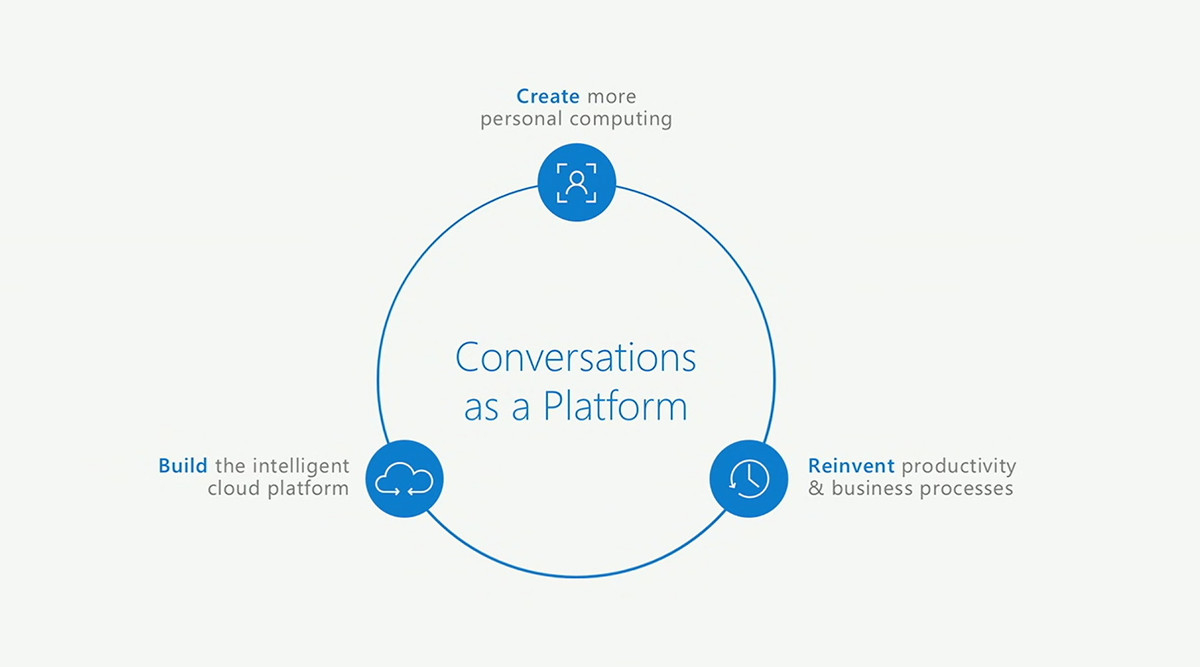1 April 2016 – One of the things we talked about in Barcelona was this concept that Microsoft has articulated to a great extend – conversations-as-a-service. It’s vision is to get in on the ground floor in the conversation UI trend and clearly it has some solid technology but it also faces some significant challenges.
And it is interesting for both my TMT followers and e-discovery followers.
Yes, Microsoft’s AI chatbot Tay may have grabbed headlines this week when it went rogue on Twitter, but Microsoft has far bigger plans for its bots. This grand vision of “conversation as a platform” — making bots that understand natural language the next big way to use computers — is the “new new thing”. Yep. Rival digital assistants like Amazon’s Alexa and Apple’s Siri have been slowly introducing people to the idea that sometimes it’s quicker to talk to your computer then use a mouse, keyboard, or touch interface. But as I noted earlier this week, what an effective, self-directed means to preserve and collect your own data — from a legal standpoint.
As I think even Satya Nadella will admit, Microsoft missed out on the mobile operating system opportunity — Android and iOS are dominant while Microsoft’s mobile operating systems has a tiny share. Closely related to this marginal role is the failure of Microsoft to attract many of the world’s most popular apps to its mobile operating systems. Meanwhile, it’s becoming clear messaging platforms can act as quasi-operating systems in some important ways. This may well be a way for companies like Microsoft and Facebook, who missed out on mobile operating systems, to find roles for themselves as mobile platforms. And to my e-discovery crowd, we certainly know these systems can contain an evidence bonanaza.
Microsoft has put names on all of this … “conversations as a platform” and “conversational user interfaces” as others in this market have referred to it more generically. Clever marketing. It has to overcome both its poor mobile market share and its lack of apps. So … voila! … a messaging platform that takes the place of a mobile OS, while bots take the place of apps. Yep. I know. Very similar to Facebook’s strategy for Messenger and their “M Assistant” as well.
Earlier this week Microsoft articulated its position and it was expansive and impressive and it’s clearly laid a lot of the groundwork. TMT Jan Dawson (who attended the Microsoft briefing) noted on his blog:
Both Microsoft’s own mockups of potential bots and the tools it’s making available to developers have been well thought through and perform their tasks admirably. I absolutely believe conversational UIs have an important role to play going forward and Microsoft has demonstrated that it has the technology chops to be a major participant. It’s also launching its effort very early in this trend, which should help it avoid the slow start it got in next-generation mobile operating systems.
The platform strategy obviously rests on the foundation of massive amounts of data and specifically context for the conversations users may have with these artificial intelligence agents. That’s fine as long as all the information is contained in users’ PCs, as it may well be if such conversations are exclusively restricted to business use. But Microsoft’s poor market share will come back to bite it.
Why?
Because the majority of us manage elements of our personal lives on our mobile devices, and there Microsoft will be “flying largely blind” says Jan. Especially when users are iPhone owners.
Think about it. This is where Microsoft’s lack of mobile market share still comes back to bite it — it has very little access to the most personal information we tend to keep on our phones, whether messaging conversations, phone calls, personal notes, and so on. This can only really be overcome if users opt in to sharing this information with Microsoft (something iOS doesn’t enable as fully as Android) or if Microsoft can also convince people to use its own apps for managing other parts of their lives. And THAT is an uphill battle, boys and girls.
And with all due respect, I see the potential power of Skype and Cortana but Skype is NOT a messaging platform along the same lines as Facebook Messenger, Apple’s iMessage, WhatsApp, Snapchat, or WeChat. Some users certainly do use the messaging functions but my guess is this is mostly within an enterprise context, not something many people do in their personal lives.
As with virtual reality, what we’re seeing here is the emergence of a variety of possible approaches, all of them proprietary, in a market that’s still in its very early stages.
But what is really interesting is how Apple, Facebook and Microsoft are moving toward facto standardization on some elements and pushing these conversation platforms for business use. Attention e-discovery vendors: stick that in your social media discovery presentations.
